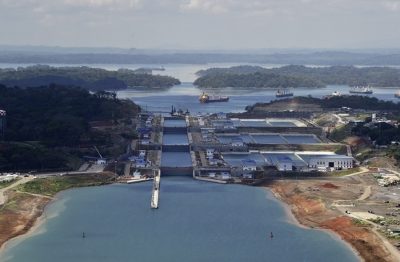Schaeffler Supplies Key Components for New Panama Canal

After a nine-year construction period, the new, third channel of the Panama Canal opened recently. Starting immediately, ships with a maximum length of 366 meters (984 feet) and a width of around 50 meters (164 feet) can travel this shortcut between the Atlantic and Pacific oceans. Until now, the passage was restricted to ships that were no more than 290 meters (951 feet) long and 32 meters (105 feet) wide. Bearing solutions from Schaeffler keep lock gates and valves moving.
Bearings for reliable lock operation
Components made by Schaeffler play a key role in the operation of the lock gates. The locks are necessary both on the Atlantic and Pacific side so that ships can overcome a difference in height of 26 meters and pass through the interior of the country. This is achieved by three consecutive locks that are flooded with water from adjoining reservoirs. The lock gates are made of reinforced concrete and have enormous dimensions of 50 meters (164 feet) wide, 30 meters (98 feet) high and 10 meters (33 feet) thick. For safety reasons, two gates have been installed for each barrage that open to the side. The mechanism for opening and closing the gates was developed by Italian engineering company Cimolai Technology. To open and close the gate, each has two main drive units that drive a cable winch. The drums of the steel cable winches are supported by spherical roller bearings made by Schaeffler. Since very high torques of up to 330,000 Nm are required to move the gates, there is also a gearbox on each that increases the torque of the electric motors by almost 280 times. The gearboxes developed by PIV Drives, a company owned by the Brevini Group, are equipped exclusively with tapered, spherical and cylindrical roller bearings made by Schaeffler. Most of the bearings have been coated with Schaeffler’s Triondur C to prevent wear and ensure their operation for 35 years.
Both at the top and at the bottom of the reservoirs, two “carriages” guide the gates that weigh 3,100 tons. The guide pulleys that are used must be able to withstand not only the weight of the, but also the pressure of 430 million liters of water per reservoir. The guide pulleys are equipped with spherical roller bearings supplied by Schaeffler.
Bearings for resource-conserving water cycle
One important feature of the new Panama Canal is its three reservoirs that are located next to each barrage. They ensure a resource-conserving water cycle. Several valves open in a channel below ground to drain the water from a barrage. The channel connects the water saving basins and the barrage. Due to the large size of up to seven meters (23 feet), the valves supplied by Hyundai Samho have also been designed as gates. The steel guide pulleys for these gates are equipped with bearings made by Schaeffler. The bearings used here are chromium-plated, making them particularly resistant to corrosion. Different variants of the Durotect coating developed by Schaeffler are used for this application.
Challenging conditions
Schaeffler Engineer Francesco Capittini describes the special challenges for bearing solutions for the Panama Canal as follows: “The slow motion causes a quasi-static load in the bearings with very high forces.”
In addition, the operation of the Panama Canal must work reliably 24/7 due to its significance for world trade. Maintenance intervals are scheduled only every five years.
Schaeffler was able to develop solutions based on standard products despite the tough requirements for technology in the expansion of the Panama Canal. The international network of engineers and application specialists also implemented project-specific solutions. Dr. Stefan Spindler, who is a member of Schaeffler’s executive board and responsible for the company’s industrial business, explains: “Our sales team is made up of engineers all over the world. They work with Schaeffler experts from a wide range of disciplines, such as coating engineers and calculation experts, which helps them provide our customers with bearing solutions for even the most challenging applications.”
Matteo Maretto, member of the development team at Cimolai Technology, the Italian engineering company that developed the mechanism for moving the lock gates, agrees: “The bearings are a very critical component for the overall functioning of the lock. They have to work under any circumstances; otherwise the entire facility would stand still. Schaeffler provided valuable support to us during development.”





